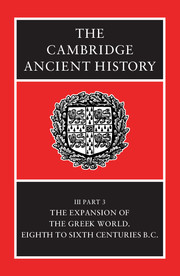Book contents
- Frontmatter
- Contents
- List of maps
- List of text-figures
- Preface
- 36a The Greeks in the Near East
- 36b The Greeks in Egypt
- 36c Cyprus
- 36d The Cypriot syllabary
- 37 The colonial expansion of Greece
- 38 The western Greeks
- 39a The eastern Greeks
- 39b Crete
- 39c Cretan Laws and Society
- 39d Euboea and the Islands
- 40 Illyris, Epirus and Macedonia
- 41 Central Greece and Thessaly
- 42 The Peloponnese
- 43 The growth of the Athenian state
- 44 The Tyranny of Pisistratus
- 45a Economic and social conditions in the Greek world
- 45b The material culture of Archaic Greece
- Chronological Table
- BIBLIOGRAPHY
- Index
- References
36b - The Greeks in Egypt
Published online by Cambridge University Press: 28 March 2008
- Frontmatter
- Contents
- List of maps
- List of text-figures
- Preface
- 36a The Greeks in the Near East
- 36b The Greeks in Egypt
- 36c Cyprus
- 36d The Cypriot syllabary
- 37 The colonial expansion of Greece
- 38 The western Greeks
- 39a The eastern Greeks
- 39b Crete
- 39c Cretan Laws and Society
- 39d Euboea and the Islands
- 40 Illyris, Epirus and Macedonia
- 41 Central Greece and Thessaly
- 42 The Peloponnese
- 43 The growth of the Athenian state
- 44 The Tyranny of Pisistratus
- 45a Economic and social conditions in the Greek world
- 45b The material culture of Archaic Greece
- Chronological Table
- BIBLIOGRAPHY
- Index
- References
Summary
Greek-Egyptian relations before Psammetichus I
Greeks arrived to settle in Egypt in the reign of Psammetichus I (664–610 B.C.). For the period that follows, Herodotus found that Egyptian and non-Egyptian information could be combined (II. 147). Thanks to Greek settlers mingling with the Egyptians, knowledge was now accurate (II. 154). Significantly, no Greek pottery datable to the period between Mycenaean times and 664 B.C. has so far been found in Egypt. Egyptian trinkets, on the other hand, were reaching the Greek world in the eighth century, and a bronze Egyptian jug at Lefkandi in Euboea would seem to date back as far as the ninth. These could have arrived by way of Phoenicia or Cyprus.
Some contact then, even if indirect, there must have been in the disturbed century before Psammetichus I. The Greeks retained some recollection of the Egyptian history of this time. We have seen how the king of Ethiopia and Egypt, who must have been Shabako (c. 716–c. 702 B.C.) in 711 surrendered Yamani of Ashdod, possibly a Greek (above, p. 16). This ‘Sabakōs’ is an historical figure for Herodotus (II. 137, 139) who in the fifth century could get a fair amount of information about the 25th (Nubian or Kushite) dynasty. Shabako's enemy was the delta king Bakenrenef son of Tefnakhte (c. 720–715 ?), whom he eventually captured and burnt alive. Bakenrenef, as Bocchoris, was to figure in Greek imagination, though Herodotus does not mention him. He is celebrated as a sagacious lawgiver in the Egyptian account of Diodorus (I. 45, 65, 79, 94) which derives from earlier Greek writing – probably in large measure from Hecataeus of Abdera, c. 300 B.C.
- Type
- Chapter
- Information
- The Cambridge Ancient History , pp. 32 - 56Publisher: Cambridge University PressPrint publication year: 1982
References
- 15
- Cited by



